Биологические науки. Рубрика в журнале - Бюллетень науки и практики
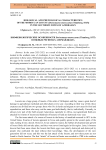
Статья научная
In the years 2021-2023, as a result of the research conducted in Masalli district, located in the southern zone of Azerbaijan, it was found that the Moroccan locust gives one full generation in these areas. Hibernation takes place in the egg stage in the carp. Larvae emerge from the eggs in the second half of April. The results obtained during the research can be used when developing measures to combat this pest.
Бесплатно
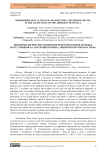
Статья научная
Although it is very difficult to study the biomorphological properties of plants according to their sensitivity to salt ions during introduction, the fact that species do not adapt to saline soils for a long time makes it necessary to conduct some experiments. The introduction of new trees and shrubs imported from abroad has become a priority in the Absheron Peninsula of the Republic of Azerbaijan, especially in the Khazar and Pirallahi regions. In this regard, chemical analyzes were carried out by analytical methods, the mechanism of action of salt ions (Cl-, SO42- and CO32-) in plants was studied, intoxication of toxic salt ions and bio indicative properties of individual ions were studied. During the study, 44 species of trees and shrubs sensitive to Cl-, SO42- and CO32- ions were selected and their salinization properties (weak, medium and high) were determined. It was found that the sensitivity of trees and shrubs to chlorine, sulfate and carbonate ions is significantly different, and the selectivity of plants to salt ions is correlated with bio indicative properties. The saline and re-salinized soils of the areas belong to the chloride-sulfate, sulfate-chloride and chloride-sulfate-carbonate types, in which high chlorine ion, medium carbonate ion and weak sulfate ions are found to cause intoxication. In saline soils, chlorine ions have been shown to form halo succulence in plants, and sulfate ions to have halo xerophytes, and trees’ species are less resistant to salt ions than shrub species.
Бесплатно
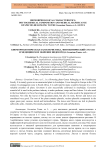
Статья научная
Geranium Tourn. ex L. is a flowering plant Genus belonging to the Geraniaceae Family. It is mainly grown as an ornamental plant in Azerbaijan. It was brought to Europe in the 17th century. Its propagation zone is South Africa. It is cultivated in many countries because it is a very valuable essential oil plant. Geranium is also successfully cultivated in Azerbaijan. Geranium essential oil is used in the perfume industry to make perfumes, soaps and face lotions. It is also used in the food industry to flavor beverages, as well as confectionery. It is also used in the preparation of medicines. Not only the leaves of the geranium plant, but also its roots, flowers and leaves are considered very good. The root of the plant contains phenols, various phenolic compounds in the upper green part, sucrose, starch and hemicellulose. The leaves and flowers are rich in phenolic carboxylic acids, vitamins, flavonoids, pigments, essential oils and carbohydrates.
Бесплатно
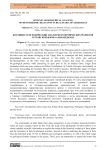
Botanic-geographical analysis of mesothermic relicts of Turgai flora of Azerbaijan
Статья научная
From the middle of the Oligocene epoch of the Paleogene period evergreen Poltava flora had been replaced by deciduous tree species of Turgai flora. The taxonomic composition of the relict trees and shrubs belonging to the Turgai flora in Azerbaijan and their botanical and geographical characteristics are analyzed in this article. In the article also analyzed the characteristics of the relict areal and the genetic varieties that stood the changes in the geological periods, while preserving its gene pool so far. In modern times, Turgai flora remaining relicts are more common in Hirkan (Azerbaijan), in Colchis (Georgia), and partially in the forests surrounding the Southern hills of the Greater Caucasus. Mesothermic plants of Turgai flora in Azerbaijan are found combining 17 families and 28 genera in 38 species of trees and shrubs.
Бесплатно
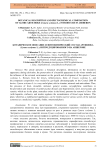
Статья научная
The article presents: a botanical description, information on the decorative appearance during cultivation, the preservation of a beautiful appearance in the winter months and the influence of the external environment on the growth and development of the species Cynara scolymus L. Extracts from the leaves, inflorescences, fruits of Cynara scolymus L. and the component composition were studied by gas-liquid chromatography on the Crystal 2000 M device. Cynara scolymus L. is a very useful plant, rich in vitamins, minerals and antioxidants. Thus, the presence of linol, citonellol, mirtenol, geranyl acetate, caryophyllene contributes to the prevention and treatment of cardiovascular diseases and hypertension; nerol, neryl acetate and synarin, which are in the plant, neutralize toxins in the blood, promote the renewal of liver cells (with hepatitis, cirrhosis), and insulin regulates the normalization of blood sugar balance. This plant, which has a multifaceted significance, can be widely used in various sectors of the national economy (as a medicinal, vegetable, fodder, ornamental plant).
Бесплатно
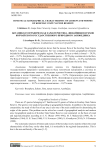
Botanical-geographical characteristic of lichens and mosses of Korchay State Nature Reserve
Статья научная
The geographical analysis shows that the mosses flora of the Korchay State Nature Reserve was not genetically homogeneous but was composed of various geographical elements included in different botanical-geographic regions. The mosses flora as a whole is boreal - 39.5%, arid - 23.7%. Euryholarctic - 15.8% and mountain species - 10.5% play a certain role in the flora. The flora of lichenes has a nemoral-continental character as a whole. Boreal - 14.0%, euryholarctic - 10.7% and hypoarctomontane - 10.7% species also play a significant role in the flora.
Бесплатно
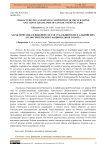
Статья научная
By the order of the President of the Republic of Azerbaijan dated April 1, 2008, Goygol National Park was established in the administrative territories of Goygol, Dashkasan and Goranboy districts from 6739 hectares to 12755 hectares. The grassland vegetation of Goygol National Park and the lake ecosystem it surrounds is one of the floristically rich regions of the Caucasus. The richness and diversity of flora is related to the geomorphological complexity of the area. On the other hand, the reserve regime allows the protection of vegetation. Modern subalpine vegetation has changed dramatically as a result of mowing and grazing. Thus, short (13-15 cm) grass or grass-steppe plant groups have formed in the place of relatively tall plants that existed earlier in many pasture areas. The flora composition of subalpine meadows is much richer than the meadow associations of other mountain zones. 70-80 (100) flowering plants were recorded in many vegetation groups. The climate of the Alpine belt is distinguished by its harshness. Short summer (2.0-2.5 months), low air and soil temperature, abundance of atmospheric precipitation, etc. are characteristic features of the alpine zone.
Бесплатно
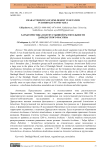
Characteristics of semi-desert vegetation in Daridagh massif area
Статья научная
This article provides information on the semi-desert vegetation type of the Daridagh Massif. It was found that the areas of the massif at an altitude of 800-1200 m are characterized by plant species specific to semi-desert vegetation. In the ecological-geobotanical research, phytocenosis dominated by Artemisetum and Salsoletum plants were recorded in the semi-desert vegetation type in the Daridagh Massif. The semi-desert vegetation type in the region was classified into 1 formation class, 2 formation groups and 8 associations. Temporary Artemisetum fields cover a large area in the plains at the foot of Daridagh Massif. Artemiseta lerchianae and Salsoleta dendroidanae formations are found here and these are the formations that attract more attention. The Artemisia lerchiana formation covers a wide area from the plain to the 1200 m altitude of Daridagh Massif. Artemisia lerchiana + Salsola nodulosa is relatively common in the lower plain parts of the Daridagh Massif. Artemisia lerchiana + Tulipa biflora + Allium rubellum + varioherbosa is found in relatively less saline and relatively stony areas, mainly in clayey stony-gravelly areas on open slopes with a slope of 5-30°. The main regulators of the varioherboso - artemioso - salsolletum dendroideae association are Artemisia lerchiana and other species.
Бесплатно
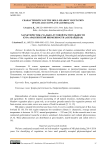
Characteristics of the Hole-Meadow Vegetation of Kur-Aras Lowland (Azerbaijan)
Статья научная
In article the description of the main types of meadow communities which were registered in Mil plain was given. It was also given their geobotanical classification. Distribution, contemporary situation, species biodiversity, morphobiological, bioecological and phytocenological features of this vegetation was analyzed. It was determined that hole-meadow vegetation type of researched area contains 4 formation classes, 14 formation groups and 39 associations.
Бесплатно
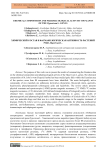
Chemical composition and pharmacological activity of plants of the Hypericum L. genus
Статья обзорная
The purpose of this work was to present the results of summarizing the literature data on the chemical composition and pharmacological activity of the Hypericum L. genus. The chemical composition of St. John’s wort (Hyperici herba) has been studied quite fully within the Eurasian area of the species; more than 80 components have been identified. The main biologically active compounds of raw materials are anthracene derivatives (hypericin), flavonoids (rutin, quercetin, hyperozoid), phenylpropanoids (chlorogenic acid) and hyperforin. The review article presents physical constants and spectroscopic ((-NMR) proton magnetic resonance, (13C NMR) 13C nuclear magnetic resonance, (-UV) ultraviolet, (-IR) infrared) interpretations of biologically active substances obtained from secondary metabolites from species belonging to genus. The results of pharmacognostic and pharmacological studies determine the feasibility of clinical trials of St. John’s wort raw materials drugs and their use in a wide therapeutic range in the complex treatment of diseases. Herba St. John’s wort is a promising source of raw materials for obtaining antibacterial, antiviral, anti-inflammatory, astringent, diuretic, antidepressant, antioxidant, anticarcinogenic, immunotropic and adaptogenic agents.
Бесплатно
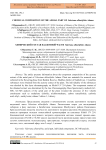
Chemical composition of the aerial part of Valeriana alliariifolia adams
Статья научная
The article presents information about the component composition of the acetone extract of the aerial part of Valeriana alliariifolia Adams. Plant raw materials for research were collected in the flowering phase from Batabat Reserve, Shahbuz district of Nakhchivan. Crystalline substances were obtained from the acetone extract of the plant. The individuality of the substances was checked by thin layer chromatography on Silufol UV 254 plates. The component content of the obtained extract was determined by the Gas Chromatography-Mass Spectrometry method (GC-MS). GC-MS analysis of the aerial part of the plant revealed the presence of five volatile constituents such us methylene chloride; trichloromethane; carbon tetrachloride; carbonic acid, ethyl-, methyl ester; ethane 2 chloro 1,1 detoxy.
Бесплатно
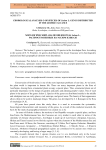
Chorological analysis of species of Sedum L. genus distributed in the Lesser Caucasus
Краткое сообщение
The Sedum L. genus is represented by 22 species in the Azerbaijan flora. According to the system of N. N. Portenier, 14 species distributed in the Lesser Caucasus were chorologically analyzed and their geographical elements were determined.
Бесплатно
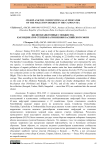
Cilioplankton communities as an indicator of the pollution degree in the Caspian Sea
Статья научная
During 2014-2021 years a study of the species diversity of planktonic ciliates of the Caspian coast of the Absheron Peninsula was conducted. As a result of research in planktonic communities of free-living ciliates, 62 species, belonging to 22 families were observed. Among the recorded families, Strombidiidae takes first place in terms of the number of species. The families Uronychiidae, Nassulidae, Epistylidae, and Zoothamniidae were represented by only one species. A correlation between similarity of the planktonic ciliates species diversity and the degree of organic pollution of coastal area marine water has been established. The results of the cluster analysis showed that the highest similarity of the species diversity (95.5%) was noted for two collection points on the northern coast of Absheron, near the settlements of Novkhani and Bilgah. This is due to the fact that the northern coast is less polluted by oil products and domestic sewage. Thus, according to the similarity of species diversity of planktonic communities of ciliates on the coast of the Absheron Peninsula, the two clusters are clearly distinguished. One unites the cleanest sites (Novkhani and Bilgah - 95.5%), and all the other 4 stationary points of the collection (Sumgait, Turkan, Shikh, Sangachal - more than 50%) are combined into the second cluster.
Бесплатно
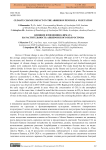
Climate change impact on the Absheron peninsula vegetation
Статья научная
Climate change is one of the global problems of modern times, and the increase in the average annual temperature in our country over the past 100 years to 0.4-1.3 °C has affected the structure and function of cultural ecosystems in the Absheron Peninsula. In order to study the impact of climate change on the peninsula, dendrochronological and dendroclimatological studies were conducted, forest assessments were analyzed. The study found that the increase in carbon dioxide in forests due to climate change in the Greater and Lesser Caucasus has affected the growth dynamics, phenology, growth, root system and productivity of plants. The increase in CO2 in the Greater Caucasus is due to the endemic, rare, endangered tree plants of Azerbaijan Quercus castaneifolia C. A. Mey., Parrotia persica (DC.) C. A. Mey., Carpinus betulus L., Pinus eldarica Medw. , and others. manifests itself more in species. As a result of warming observed in forests in the northern regions of the Greater Caucasus, an increase in the annual ring remnants of young trees was observed in 2010-2020 compared to 1850. Rapid growth of plants was observed in the early stages of plant growth in areas where the concentration of CO2 in the atmosphere increased. At the same time, it should be noted that the excessive increase in CO2 in forests caused drought stress in July and August. Although climate change has affected the physiology and growth of trees in the study, increasing ozone in the area balances it by resisting the positive effects of CO2.
Бесплатно
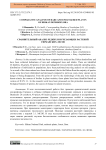
Comparative analysis of rare and endangered plants of Hirkan dendroflora
Статья научная
In the research work has been comparatively analyzed the Hirkan dendroflora and have been collected herbariums of rare and endangered trees and shrubs. There are identified 26 families, 40 genera, 60 species of rare and endangered trees and shrubs naturally spreading areas, distribution of individuals in populations, have been performed tree-ring analysis on old samples. As a result of the observations have been determined, that in the Hirkan flora the majority of species in the areas have been diminished and decreased compared to previous years, many species are in danger of being disappeared. From this point of view by the monitorings of the area were studied threat criteria, the reasons of decline in plant varieties, those plants have been identified based on version of IUCN 3.1. In the research work have been processed out the protection measures, the biological features of species, the causes of change in natural resources.
Бесплатно
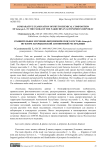
Статья научная
Data are presented on the biomorphoecological characteristics, comparative phytochemical composition, distribution, pharmacological effects, and the possibility of use in scientific and folk medicine of species belonging to the genus Satureja L. of the genus Lamiaceae Lindl. The object of study are 2 species common in the Autonomous Republic of Nakhchivan: Satureja macrantha C. A. Mey. (large-flowered savory) and Satureja hortensis L. (garden savory). The current state of populations of large-flowered and garden mint species has been studied, and environmental changes have been identified. To carry out the chemical composition, plants of these species were dried, crushed and prepared for analysis in the laboratory under standard conditions. The oil was extracted and analyzed by hydrodistillation (Ginsberg). The resulting oil was analyzed on a chromatographic installation Crystal 2000 M. Essential oils were isolated and analyzed. The substances under study are used in medicine.
Бесплатно
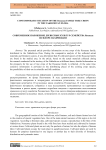
Contemporary situation of the Rosaceae family tree crops in the Nakhchivan flora
Статья научная
The presented article provides information on tree crops of the Rosaceae family, distributed in the Nakhchivan flora. During the comparative analysis of the collected actual materials and literature sources, it was determined that 20 cultivated species of the Rosaceae family are found in the studied area. In the article, based on the actual materials collected during the research conducted in the territory of the Nakhchivan at different times, detailed information on the prospects for the use of tree crops of the Rosaceae family is reflected. At the same time, extensive information is provided on the distributing places of the existing crops species, the possibilities of their use in scientific and folk medicine.
Бесплатно
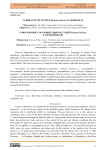
Current state of wild Pistacia lentiscus in Azerbaijan
Статья научная
Information is provided on Pistacia lentiscus L. belonging to natural forest vegetation, Anacardiaceae family, Pistacia genus. Information is given on the modern status and importance of Pistacia lentiscus L., which is one of the wild tree species in the flora of Azerbaijan. Due to its resin content, the Pistacia lentiscus is a valuable plant that is resistant to pests and used in various fields. The Pistacia lentiscus is a long-lived tree that coexists with other forest plants.
Бесплатно
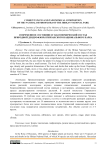
Current status and taxonomical composition of the natural dendroflora of the Hirkan National Park
Статья научная
The current state of the natural dendroflora of the Hirkan National Park was analyzed, an inventory of natural and cultivated plant species was carried out, the impact of climate change on biodiversity, the taxonomic composition of trees and shrubs, dominant species, and the distribution areas of the studied plants were comprehensively studied. In the forest ecosystem of Hirkan National Park, the area where the plants live change in several directions. In the deep layers of the forest, the sun hits a small amount. The level of illumination depends on the composition, age, density and geometric dimensions of the trees and shrubs that make up the forest. Depending on the amount of light, more or less shade-tolerant species grow in the lower tiers of the forest. Hirkan National Park has undergone anthropogenic impact in recent years. The forest usually consists of 2-3 tiers.
Бесплатно
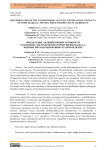
Статья научная
The article presents the research results on the microbiological activity of some Passiflora genus species, first introduced in Azerbaijan. Phytochemical compounds were analyzed in vitro in ethanolic extracts of Passiflora incarnata L. , P. edulis Sims, P. caerulea L. leaves and fruits to determine the antimicrobial activity against six pathogenic bacteria. The activity indicators of ethanolic extracts from leaves and fruits of all three species were compared. Leaf extracts were found to have higher antibacterial activity compared to fruit extracts. Ethanolic extracts of Passiflora edulis Sims were more active than extracts from P. incarnata L. and P. caerulea L. The results of the study may contribute to the development of new medications against pathogenic microbes and the progress of the pharmaceutical industry in the future.
Бесплатно

